|
|
|
Sort Order |
|
|
|
Items / Page
|
|
|
|
|
|
|
| Srl | Item |
| 1 |
ID:
175894
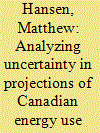

|
|
|
|
|
| Summary/Abstract |
This paper analyzes the uncertainty associated with Reference Case, or baseline, projections of Canadian energy use and production. We use the Canada Energy Regulator's Energy Futures modeling system to explore the impacts of changing key assumptions. The choice of assumptions and magnitude of change are guided by the scenarios in the Energy Modeling Forum (EMF) 34 project. We find important variations across all scenarios. In particular, we note that Canada's role as an energy producer is important for interpreting projection and scenario results. Overall, this analysis shows that it is important to test key assumptions in a typical Reference Case projection. However, this analysis also highlights many complexities in energy system modeling. It is also important to consider the potential interplay between key variables. This speaks to the importance of broader scenario analysis, where multiple assumptions are changed in an internally consistent way, as a useful complement to the focused scenario analysis found in this paper.
|
|
|
|
|
|
|
|
|
|
|
|
|
|
|
|
| 2 |
ID:
101373
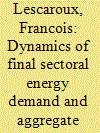

|
|
|
|
|
| Publication |
2011.
|
| Summary/Abstract |
This paper proposes a regional and sectoral model of global final energy demand. For the main end-use sectors of consumption (industrial, commercial and public services, residential and road transportation), per-capita demand is expressed as an S-shaped function of per-capita income. Other variables intervene as well, like energy prices, temperatures and technological trends. This model is applied on a panel of 101 countries and 3 aggregates (covering the whole world) and it explains fairly well past variations in sectoral, final consumption since the beginning of the 2000s. Further, the model is used to analyze the dynamics of final energy demand, by sector and in total. The main conclusion concerns the pattern of change for aggregate energy intensity. The simulations performed show that there is no a priori reason for it to exhibit a bell-shape, as reported in the literature. Depending on initial conditions, the weight of basic needs in total consumption and the availability of modern commercial energy resources, various forms might emerge.
|
|
|
|
|
|
|
|
|
|
|
|
|
|
|
|
| 3 |
ID:
116949
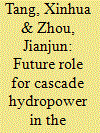

|
|
|
|
|
| Publication |
2012.
|
| Summary/Abstract |
Due to the dominance of coal power, the electricity sector is the primary contributor of greenhouse gas emissions in China. The increase of peak-load and intermittent renewable power requires significant resources of regulation facilities. Comprehensively utilizing large-scale cascade hydropower plants (CHPPs), which are being rapidly developed in China, as renewable regulating facilities would be a strategic decision, considering the flexibility of hydropower. Jointly modeling a set of CHPP in the upstream Yangtze River indicated that the CHPP can regulate peak-load up to 30-40 GW and intermittent renewables to scales of nearly 15 GW from wind and solar sources with the help of ±800 KV ultra-high voltage direct current (UHVDC) transmissions. The present study shows that the hydraulic stability of the concerned river reaches can be preserved easily and the comprehensive efficiency of regulation and transmission by CHPPs is much higher than that of pumped hydro energy storage (PHES) stations. As increasingly more giant CHPPs emerge in west China, using them primarily as regulating facilities can enhance the structure of power grids, promote the development of renewables, save energy and reduce emissions. Thus we propose to shift the CHPPs that were originally projected mainly for electricity to facility primarily for power improvement.
|
|
|
|
|
|
|
|
|
|
|
|
|
|
|
|
| 4 |
ID:
093497
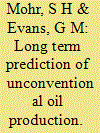

|
|
|
|
|
| Publication |
2010.
|
| Summary/Abstract |
Although considerable discussion surrounds unconventional oil's ability to mitigate the effects of peaking conventional oil production, very few models of unconventional oil production exist. The aim of this article was to project unconventional oil production to determine how significant its production may be. Two models were developed to predict the unconventional oil production, one model for in situ production and the other for mining the resources. Unconventional oil production is anticipated to reach between 18 and 32 Gb/y (49-88 Mb/d) in 2076-2084, before declining. If conventional oil production is at peak production then projected unconventional oil production cannot mitigate peaking of conventional oil alone.
|
|
|
|
|
|
|
|
|
|
|
|
|
|
|
|
| 5 |
ID:
124154


|
|
|
|
|
| Publication |
2013.
|
| Summary/Abstract |
This study presents a model of an ecotechnology that combines algae cultivation with anaerobic digestion in order to recycle nutrients and to reduce the need for external energy. The concept is to convert organic waste into several products, such as electricity, biodiesel and organic fertilizer. It is labeled as the ACAD biorefinery. The simulation model of the ACAD biorefinery proved itself to be a powerful tool for understanding the symbioses and dynamics of the system, and therefore also a good tool for reaching political decisions. The model shows that the ACAD biorefinery could be totally independent of external energy supplies. Energy calculations indicate that more energy can be produced by combining the algae cultivation and anaerobic digestion processes. For every unit of energy entering the system in feedstock, 0.6 units of energy are exported as either biodiesel or electricity. The exported electricity accounts for approximately 30% of the total exported energy, while the remaining 70% is exported as biodiesel. By producing its own energy, the biorefinery improves its renewability and level of carbon neutrality.
|
|
|
|
|
|
|
|
|
|
|
|
|
|
|
|
| 6 |
ID:
143703


|
|
|
|
|
| Summary/Abstract |
The authors examine the basic aspects of combat action modeling for use in military research in general, and for justification of efforts to develop advanced weapons systems in particular. They take a critical view of the modeling systems in the Russian and foreign armed forces and urge for prompt measures to be taken to develop a national system for modeling combat actions to add significantly to the potentialities of the national military science. The authors suggest that an academic conference be convened to draw up specific methodological recommendations on development of a modeling system in the Russian Armed Forces.
|
|
|
|
|
|
|
|
|
|
|
|
|
|
|
|
| 7 |
ID:
102095
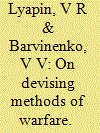

|
|
|
|
|
| Publication |
2010.
|
| Summary/Abstract |
The views are expounded on the essence and content of the methods of warfare, as well as on the methodological approach to determining how these are influenced by weapons characteristics and military art principles.
|
|
|
|
|
|
|
|
|
|
|
|
|
|
|
|
| 8 |
ID:
180673


|
|
|
|
|
| Summary/Abstract |
We examine the research protocols in Blair and Sambanis’ recent article on forecasting civil wars, where they argue that their theory-based model can predict civil war onsets better than several atheoretical alternatives or a model with country-structural factors. We find that there are several important mistakes and that their key finding is entirely conditional on the use of parametrically smoothed ROC curves when calculating accuracy, rather than the standard empirical ROC curves that dominate the literature. Fixing these mistakes results in a reversal of their claim that theory-based models of escalation are better at predicting onsets of civil war than other kinds of models. Their model is outperformed by several of the ad hoc, putatively non-theoretical models they devise and examine. More importantly, we argue that rather than trying to contrast the roles of theory and “atheoretical” machine learning in predictive modeling, it would be more productive to focus on ways in which predictive modeling and machine learning could be used to strengthen extant predictive work. Instead, we argue that predictive modeling and machine learning are effective tools for theory testing.
|
|
|
|
|
|
|
|
|
|
|
|
|
|
|
|
| 9 |
ID:
137505
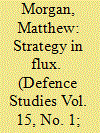

|
|
|
|
|
| Summary/Abstract |
In response to the uncertain geopolitical environment which confronted it after the end of the Cold War, NATO adopted a strategy of risk management. Two institutions – the Science and Technology Office and Allied Command Transformation – were responsible for translating this policy into practice. By promoting knowledge development, each institution sought to make NATO a more reflexive and responsive organization. Knowledge development became the foundation for a new model of command and control created by two Science and Technology Office working groups. While this model has vast potential, its implementation has been blocked by internal rifts within NATO.
|
|
|
|
|
|
|
|
|
|
|
|
|
|
|
|
| 10 |
ID:
114484
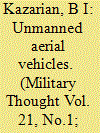

|
|
|
|
|
| Publication |
2012.
|
| Summary/Abstract |
The author looks at the specifics of the development and employment of unmanned aerial vehicles (UAVs), their integration into reconnaissance, fire, and control systems, their more functional payloads, mission tasks, and ways in which they provide information and support to combat computer networks
|
|
|
|
|
|
|
|
|
|
|
|
|
|
|
|
|
|
|
|
|